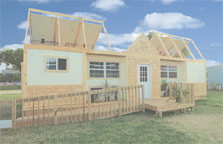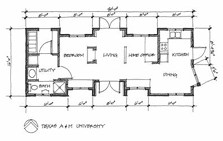

Texas A&M took traditional technologies and improved them in their home.
Click drawing to view a larger image.

Solar Decathlon 2002
Texas A&M University
Final Overall Points: 121.136
Final Overall Standing: 14
We need to start building a bridge. You don't have to eat only vegetables and live off of the grid. You need to take a couple of these energy efficiency ideas, start with one at a time, and get to a goal of using less energy.—Anthony Saccoccio, Texas A&M team member
About the Home
Texas A&M prides itself on being one of the best construction science schools in the country, so it's no surprise that this team used cutting-edge construction science to design and develop its solar home. The students took traditional technologies, modified them, and then applied them using principles of buildings and energy efficiency.
A unique feature of the home is an interior thermal wall filled with water. The water is circulated, heated, and cooled in the wall. The concept comes from refrigeration technology—the technology takes a traditional condenser system and submerges it in water.
Believing that a typical refrigerator, with a freezer and a cooling compartment, is very inefficient, the team also designed its own refrigeration appliance. The team did not necessarily choose the most efficient appliances available. Instead, the students chose an appliance and then adapted it to make it more efficient.
About the Team
"If you look at our team, it mirrors the very concept of America. We have an electrician, a plumber, a framer, architects, engineers—and we take the best of their ideas and put them in. It's like the great melting pot of ideas," says Texas A&M decathlete Anthony Saccoccio.
In keeping with the construction science emphasis at their university, the Texas A&M decathletes focused on communicating with the building and construction community—the contractors, builders, engineers, and architects that the team felt had been largely overlooked. "We are pushing a construction science education, to educate the constructors and builders, not necessarily just the architects. We want to target the people that install the technologies, such as the manufacturers and contractors," Anthony said. "They're the ones that will let people know about these features; they will influence the homeowners the most."
Unfortunately, this team was unable to participate in most of the competitions because decathletes were unable to be present during the competition week.
Key Home Features
| Item | Specifics |
|---|---|
| PV kilowatts (standard test condition rating) | 3.60 |
| PV modules | 12 ASE 300 |
| Charge controllers | 2 Trace C40 |
| Inverters | 2 Trace SW5548 |
| Battery bank | 1156 ampere-hour, 48 volt |
| Battery type | Rolls flooded lead acid |
| Water heating | Progressive tube thermal system |
| Construction | Structural insulated panels (SIPs); walls = R30 (RSI 5.3), floor and roof = R55 (RSI 9.6) |
| Space heating | Water source heat pump |
| Space cooling | Water source heat pump |
Manufacturers' Web Sites
- RWE Schott Solar Systems (formerly ASE Americas; ASE modules)
- Xantrex (formerly Trace; Trace charge controllers)
- Rolls Battery Engineering
Source: These details have been adapted with permission from Home Power #94, April/May 2003
